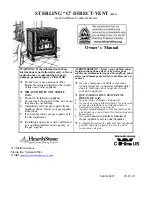
PLATINUM
WATER HEATER
17
PV500-37C 06/12
4. Install a manual main gas shutoff valve between the appliance gas valve and the gas supply piping when
needed for appliance isolation during gas supply piping pressure testing (see above) or when Local Codes
require.
5. A sediment trap (drip leg) MUST be provided in the inlet of the gas connection to the unit installed per the
sediment trap manufacturer’s instructions and/or local code.
6. The appliance combination valve/regulator bias port utilizes a vent limiter and must respond to pressure
changes in the lower burner compartment (formed by lower front and rear cowling), as opposed to
atmospheric pressure. For proper operation, do not alter, connect to atmosphere or relocate the combination
gas valve/regulator or its bias port.
8.4
Gas Train and Controls Certification
NOTE
: The gas train and controls assembly provided on this unit have been tested under the applicable
American National Standard or UL standard to meet minimum safety and performance criteria such as safe
lighting, combustion and safety shutdown operation.
8.5
Gas Control Trains
All gas control trains include a union, located between the combination valve and blower and which may contain
a factory installed orifice, a combination gas valve and a final manual shutoff valve (with gas supply pressure
tap) located outside the right side water heater support leg.
9.
GENERAL INFORMATION ON WATER CONNECTIONS AND USE
9.1
Water Inlet and Outlet Connections
Make inlet and outlet water connections directly to the two inch NPT bolt-on bronze tank flanges. Over tightening
connections to the flanges may cause damage to the flange or tank and are not covered by warranty. For ease
of service, install unions on inlet and outlet piping to the unit. Do not use galvanized nipples to make tank
connections as these will cause corrosion and rust. Piping and components connected to the water heater must
be suitable for potable water, for the water temperatures they will experience and for their application.
9.2
Filling the Unit
1. Fill the system with water. To be sure that the unit is not “air bound,” open the relief valve. Leave the valve
open until a steady flow of water is observed. Close valve and complete filling the system.
2. In hard water areas, potable water treatment should be used to reduce introduction of minerals into the
system. Minerals in the water can collect on the tubes and heat-exchanger surfaces reducing the life of the
product. Heat exchanger failure due to scale accumulation is not covered by the product warranty.
3. Make sure there are no system leaks.
DO NOT
use petroleum based stop-leak products. All system leaks
must be repaired.
MULTIPLE UNIT INSTALLATIONS GAS PIPING SIZE CHART
Maximum Capacity of Pipe in Thousands of BTU’s per hour for gas pressures of 14 Inches Water Column (0.5
PSIG) or less and a pressure drop of 0.05 Inch Water Column (Based on NAT GAS, 1025BTU’s per Cubic Foot
of Gas and 0.60 Specific Gravity).
Nominal
Iron Pipe
Size, Inches
Length of Pipe in Straight Feet
10 20 30 40 50 60 70 80 90 100 125 150 175 200
3/4
369 256 205 174 155 141 128 121 113 106 95 86 79 74
1
697 477 384 328 292 267 246 256 210 200 179 164 49 138
1 1/4
1400 974 789 677 595 543 502 472 441 410 369 333 308 287
1 1/2
2150 1500
1210
1020 923 830 769 707 666 636 564 513 472 441
2
4100 2820 2260 1950 1720 1560
1440 1330 1250 1180 1100 974 871 820
2 1/2
6460 4460 3610 3100 2720 2460
2310 2100 2000 1900 1700 1540 1400 1300
3
11200 7900 6400 5400 4870 4410
4000 3800 3540 3300 3000 2720 2500 2340
4
23500 16100
13100
11100 10000
9000
8300 7690 7380 6870 6150 5640 5130 4720















































